Imaging Myelin+
Imaging Myelin+
Oral
Oral
Contrast Mechanisms
Tuesday, 14 May 2019
| Room 520A-F | 08:15 - 10:15 | Moderators: Dong-Hyun Kim, Bruce Pike |
| 08:15 |
0420 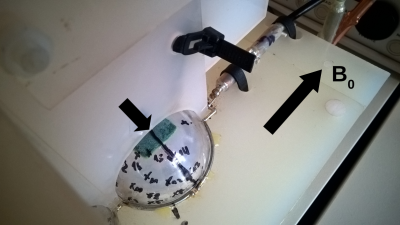 |
Biophysically motivated efficient estimation of spatially isotropic component from a single, standard gradient recalled echo measurement Video Permission Withheld
Sebastian Papazoglou, Tobias Streubel, Mohammad Ashtarayeh, Kerrin Pine, Evgeniya Kirilina, Markus Morawski, Carsten Jäger, Stefan Geyer, Martina Callaghan, Nikolaus Weiskopf, Siawoosh Mohammadi
Gradient recalled echo-based measurements
are sensitive to the degree of myelination of white matter fibres and their local orientation inside the magnetic field of the MR scanner. This orientation dependence has been observed experimentally and could be explained biophysically by anisotropic susceptibility of the myelin sheaths. In case of single, quantitative measurements
the orientation dependence represents a potential confounder, since the observed would
be biased by the sample’s orientation inside the scanner. Here, we propose an efficient method for separating into
orientation dependent and independent components based on a biophysically motivated higher order decay
model.
|
08:27 |
0421. 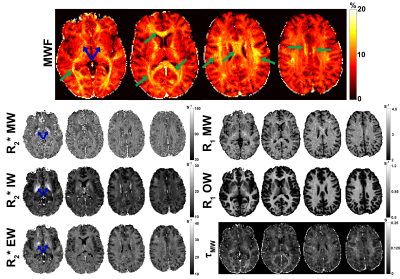 |
Brain tissue multi-compartment relaxometry - An improved method for in vivo myelin water imaging
Kwok-Shing Chan, José Marques
In this study, we propose an extension to GRE based myelin water fraction techniques based on 3-comparment models. The new model includes T1 and chemical exchange effects between a free water pool and a myelin water pool and can be fitted to a variable flip angle acquisition strategy. Furthermore, we demonstrate that it can both correct the T1 dependency in MWF, make the fitting procedure less ill-posed and more SNR efficient, resulting in robust estimation across subjects.
|
| 08:39 |
0422. 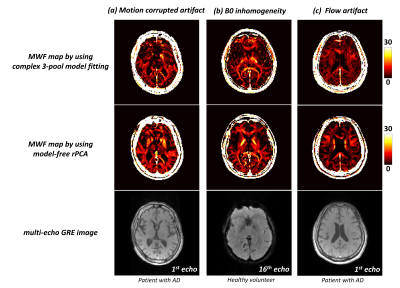 |
Noise sensitivity study of model-free rPCA in Myelin Water Fraction Mapping using multi-echo GRE
Jae Eun Song, Jaewook Shin, Hongpyo Lee, Won-Jin Moon, Mina Park, Dong-Hyun Kim
Recently, a robust principle component analysis (rPCA) method was implemented to myelin water fraction (MWF) mapping using mGRE data. Based on the intrinsic nature of T2* relaxation, hankelization and non-negative matrix factorization was implemented to enhance low rankness of each rank-1 component. In this study, the noise sensitivity of model-free rPCA was investigated. According to simulation and in vivo analysis, model-free rPCA technique is more robust at noise and other physiological artifacts than model-based fitting technique.
|
| 08:51 |
0423. 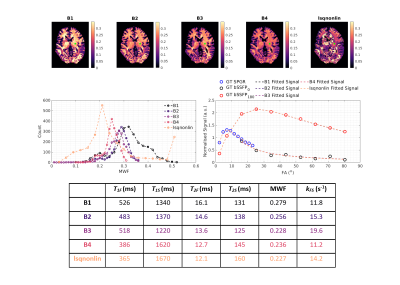 |
Inherent bias in multi-component DESPOT myelin water fraction estimation.
Daniel West, Rui Teixeira, Tobias Wood, Joseph Hajnal, Jacques-Donald Tournier, Shaihan Malik
mcDESPOT is a quantitative relaxometry technique that enables estimation of myelin water fraction (MWF) in a clinically feasible acquisition time with high signal-to-noise ratio efficiency. Many studies show in-vivo MWF maps with realistic grey matter-white matter contrast, which conflicts with statistical analyses suggesting that parameter estimation should be inaccurate and imprecise. We show that the parameters (including MWF) and their corresponding variance are indeed ill-conditioned, but their estimation is strongly influenced by the typically used fitting approach (stochastic region contraction). We also demonstrate that this degeneracy arises primarily from intercompartmental exchange.
|
| 09:03 |
0424. 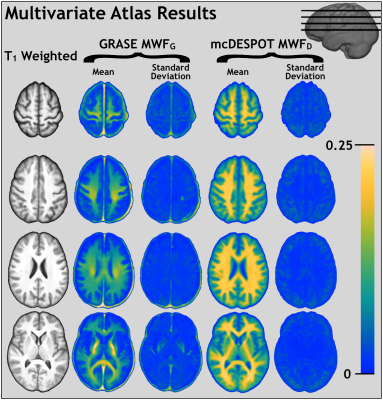 |
Multivariate template creation of a myelin water brain atlas with GRASE and mcDESPOT
Adam Dvorak, Hanwen Liu, Emil Ljungberg, Irene Vavasour, Lisa Eunyoung Lee, Alex MacKay, Roger Tam, David Li, Alex Rauscher, Cornelia Laule, Shannon Kolind
Myelin water imaging (MWI) techniques provide metrics with high specificity to myelin content, and benefit greatly from an efficient, standardized method for data interpretation. In this study, high performance diffeomorphic normalisations are used to create a myelin water atlas; statistics related to MWI metrics at each point in a template space. Multivariate template creation methods were used to simultaneously leverage anatomical features from two popular MWI techniques (GRASE and mcDESPOT). The resulting multivariate myelin water atlas can be used in future studies with either technique and provides insight into their differences.
|
| 09:15 |
0425. 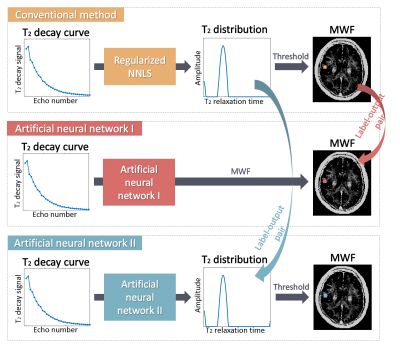 |
Real-time processing of myelin water imaging using artificial neural network
Jieun Lee, Doohee Lee, Joon Yul Choi, Dongmyung Shin, Hyeong-Geol Shin, Jongho Lee
In this study, a real-time processing method for GRASE myelin water imaging is proposed by using an artificial neural network. Two different networks, one pairing multi-echo measurement with myelin water fraction and the other pairing multi-echo measurement with T2 distribution, were developed. Both networks took <1.5 sec for the whole brain processing (FOV = 240×180×112 mm3 and matrix = 160×120×28) with less than 5% error in white matter.
|
| 09:27 |
0426. 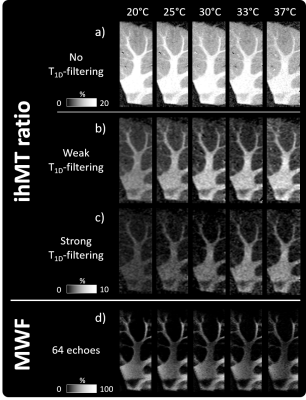 |
The influence of temperature on two ex vivo myelin specific imaging protocols: Inhomogeneous Magnetization Transfer and Myelin Water Imaging
Valentin Prevost, Sarah Morris, Andrew Yung, Irene Vavasour, Carl Michal, Erin MacMillan, Wayne Moore, Cornelia Laule, Alex MacKay, Piotr Kozlowski
The impact of temperature on inhomogeneous magnetization transfer (ihMT) measurements in formalin-fixed human brain was studied. White matter (WM) ihMT signal increased with temperature when a T1D-filter was applied, supporting the hypothesis that components with long T1D (>1ms) are more sensitive to temperature variations. Grey matter ihMT did not vary with temperature. This suggests a difference in T1D values between WM and GM, and confirms that several T1D components contribute to myelin ihMT. Myelin water fraction values decreased with increasing temperature, possibly due to faster exchange between water compartments. Temperature is an important factor to consider in order to characterize the microstructure.
|
| 09:39 |
0427.  |
Steady-state imaging with “inhomogeneous” MT contrast
Shaihan Malik, Rui Pedro Teixeira, Joseph Hajnal
A matrix-based framework for modelling of inhomogeneous MT effects was developed for steady-state gradient echo sequences. This was applied to sequences using multi-band pulses that are designed to create some off-resonance saturation simultaneously with excitation of free water. Simulations and phantom results show that ihMT contrast can be achieved in this way, and in-vivo results show the expected strong white-matter contrast.
|
| 09:51 |
0428. 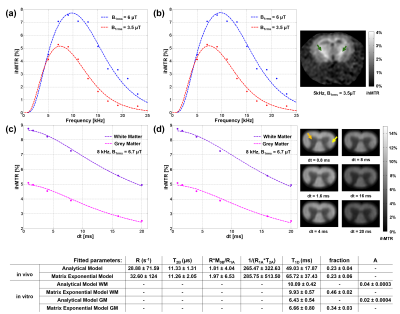 |
Toward quantitative inhomogeneous magnetization transfer (qihMT) using a general Matrix Exponential Model
Andreea Hertanu, Olivier Girard, Victor Carvalho, Lucas Soustelle, Gopal Varma, David Alsop, Guillaume Duhamel
Inhomogeneous magnetization transfer is becoming an important tool in the detection of demyelinating pathologies, as well as in the understanding of the molecular mechanisms engaged in demyelinating/remyelinating processes. Although ihMT ratio delivers a reproducible index sensitive to the dipolar order underpinning the ihMT effect, advanced approaches analogous to quantitative MT could allow estimation of quantitative parameters directly related to the underlying biophysical model of myelin. This study proposes a general framework based on the Matrix Exponential Model allowing fast fitting of ihMT data. Demonstration of qihMT is performed ex-vivo on rat spinal cord specimen and in-vivo on mouse brain.
|
10:03 |
0429.  |
Fast Bound Pool Fraction mapping via steady-state MT saturation using single-shot EPI
Marco Battiston, Torben Schneider, Francesco Grussu, Marios Yiannakas, Ferran Prados, Claudia Gandini Wheeler-Kingshott, Rebecca Samson
The bound pool fraction (BPF) is a quantitative parameter that reflects macromolecular tissue fraction, and has shown sensitivity to myelin content in human white matter. BPF mapping is still largely unexploited for characterizing white matter disease in vivo due to the long MRI protocols needed for its accurate and precise computation. In this work, we develop a new method that allows fast unbiased BPF estimation, suitable for clinical applications.
|
 Back to Program-at-a-Glance |
Back to Program-at-a-Glance |  Back to Top
Back to Top